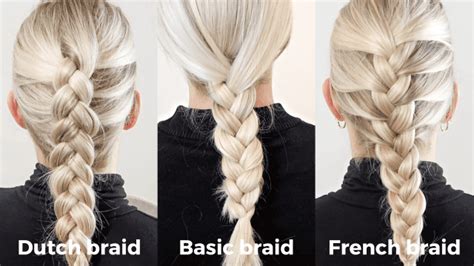Braids are a timeless and versatile hairstyle that can be worn by people of all ages and hair types. While there are many different types of braids, two of the most popular are Dutch braids and French braids. Both of these braids are beautiful and can be used to create a variety of looks, but they also have some key differences.

Dutch Braids: A Deeper Dive
Dutch braids are also known as inside-out braids or inverted braids. They are created by crossing the strands under each other, rather than over each other like in a French braid. This creates a raised, textured effect that is both eye-catching and secure.
Advantages of Dutch Braids
- Volume: Dutch braids create more volume than French braids, making them a good choice for people with fine or thin hair.
- Security: Dutch braids are very secure, making them a good choice for active people or those who want their braids to last all day.
- Versatility: Dutch braids can be worn in a variety of ways, including updos, ponytails, and buns.
Disadvantages of Dutch Braids
- Time-consuming: Dutch braids can be more time-consuming to create than French braids.
- Tension: Dutch braids can be tight on the scalp, which can cause discomfort for some people.
- Damage: Dutch braids can damage hair if they are not done correctly.
French Braids: A Closer Look
French braids are also known as outside-in braids or classic braids. They are created by crossing the strands over each other, rather than under each other like in a Dutch braid. This creates a smooth, elegant effect that is perfect for formal occasions.
Advantages of French Braids
- Ease of creation: French braids are relatively easy to create, making them a good choice for beginners.
- Comfort: French braids are less tight on the scalp than Dutch braids, making them more comfortable to wear.
- Less damage: French braids are less likely to damage hair than Dutch braids.
Disadvantages of French Braids
- Less volume: French braids create less volume than Dutch braids, making them a less suitable option for people with fine or thin hair.
- Less secure: French braids are less secure than Dutch braids, making them more likely to come loose.
- Less versatility: French braids are less versatile than Dutch braids, as they are not as well-suited to updos and other elaborate hairstyles.
The Verdict: Which Braid is Right for You?
Ultimately, the best braid for you depends on your individual preferences and hair type. If you are looking for a voluminous, secure braid that can be worn in a variety of ways, then a Dutch braid is a good choice. If you are looking for an easy-to-create, comfortable braid that is perfect for formal occasions, then a French braid is a better option.
Tips and Tricks
- Use a brush to smooth your hair before braiding to prevent tangles.
- Start your braid close to the crown of your head to create more volume.
- Keep your hair taut as you braid to prevent it from becoming loose.
- Secure your braid with a hair tie or bobby pins.
Common Mistakes to Avoid
- Braiding too tightly: This can cause discomfort and damage to your hair.**
- Using too much product: This can make your hair greasy and weigh it down.**
- Not securing your braid properly: This can cause it to come loose.**
Additional Applications
Braids can be used for a variety of purposes beyond just hairstyling. For example, they can be used to:
- Create jewelry: Braided leather or cord can be used to make necklaces, bracelets, and earrings.
- Decorate clothing: Braids can be sewn onto clothing to create unique and stylish embellishments.
- Make baskets: Braided fabric or yarn can be used to make sturdy and attractive baskets.
Innovative Ideas
Here are some creative new ways to use braids:
- Braided hair extensions: Braids can be used to create clip-in or sew-in hair extensions that add volume and length to your hair.
- Braided headbands: Braids can be wrapped around your head to create a stylish and functional headband.
- Braided belts: Braided leather or fabric can be used to make unique and eye-catching belts.
Conclusion
Braids are a versatile and beautiful hairstyle that can be worn by people of all ages and hair types. Dutch braids and French braids are two of the most popular types of braids, and each has its own unique advantages and disadvantages. Ultimately, the best braid for you depends on your individual preferences and hair type.
Table 1: Comparison of Dutch Braids and French Braids
| Feature | Dutch Braid | French Braid |
|---|---|---|
| Appearance | Raised, textured | Smooth, elegant |
| Volume | More volume | Less volume |
| Security | More secure | Less secure |
| Versatility | More versatile | Less versatile |
| Time to create | More time-consuming | Less time-consuming |
| Comfort | Less comfortable | More comfortable |
| Damage to hair | More likely to damage hair | Less likely to damage hair |
Table 2: Pros and Cons of Dutch Braids
| Pros | Cons |
|---|---|
| More volume | More time-consuming |
| More secure | More tension |
| More versatile | Can damage hair |
Table 3: Pros and Cons of French Braids
| Pros | Cons |
|---|---|
| Less time-consuming | Less volume |
| More comfortable | Less secure |
| Less likely to damage hair | Less versatile |
Table 4: Innovative Ideas for Braid Applications
| Application | Description |
|---|---|
| Braided hair extensions | Clip-in or sew-in hair extensions that add volume and length to your hair |
| Braided headbands | Braids that are wrapped around your head to create a stylish and functional headband |
| Braided belts | Braids that are made of leather or fabric to create unique and eye-catching belts |
